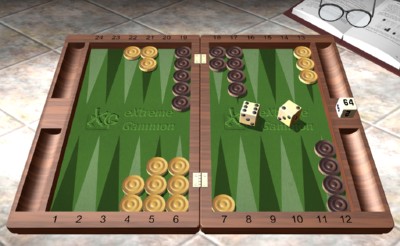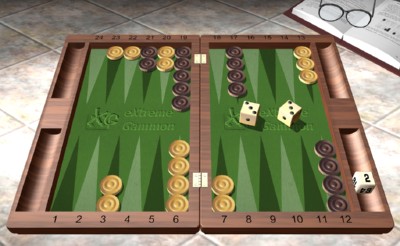One of the most common middle game structures in backgammon is the holding game, where at least one side has made an advanced anchor, and the other side has to get his checkers home while leaving as few shots as possible. Holding games are even more common now than previously, because of the tendency to split the back men with most opening rolls, which tends to result in anchors for both sides.
Here are a couple of examples of interesting holding game problems:
(A) Cash game, center cube.

White to play 6-2.
(B) Cash game, White owns the cube.

White to play 3-3.
Holding games don’t come in just one flavor. I like to break them into four main groups, as follows:
Group 1: Pure Holding Game. In these games the defender has an anchor on the 18, 20, or 21-points, and no other men back. The other side has escaped all his back men at least as far as his midpoint.
Group 2: Mutual Holding Game. Here both sides have made an advanced anchor, and usually have their midpoints as well. This form of the game doesn’t usually last long. Both sides have a lot of pips tied up in key points, and are quickly faced with issues of which point to break.
Group 3: Holding Game with 3rd Checker Back. Here one player has an advanced anchor, plus a straggler somewhere behind the anchor. The other side has escaped his checkers to at least his midpoint. These positions are considerably trickier than the basic holding games. The side with the straggler has to decide when it ceases to be an asset and becomes a liability. Should he leave it where it is? Should he move it up to the anchor if he can? Should he run it into the outfield? The side coming home has some decisions of his own. Should he play safe? Should he attack the straggler? How does the straggler affect the doubling decisions?
Group 4: Holding Game with 3rd and 4th Checkers Back. Once in a while you’ll see a position with two stragglers in the board, creating even more possibilities. Now there’s a chance the stragglers can form a second anchor, which makes them a real asset. On the other hand, they’re targets for an attack, which makes them a real liability. When do you run them out? When should you leave them alone?
Here are a few guidelines for handling the anchor plus straggler positions.
1) The Race: The farther behind in the race, the more you want to leave the straggler alone. The straggler guards points and creates some blot numbers for your opponent, so the farther behind you are, the more you need your straggler.
2) Closeness to the Anchor: The less distance between the straggler and the anchor, the less work the straggler does. The ideal spot for the straggler is back on your opponent’s ace-point, where he guards the most open points.
3) Blot Numbers: The more blot numbers your opponent has, the more you want to leave the straggler where he is.
4) Opponent’s Home Board: The stronger your opponent’s board, the less work your straggler is doing. His value is guarding open points, so the fewer open points, the less work he does.
5) Opponent’s Attacking Chances: The more numbers that point on your straggler, the more of a liability he becomes.
Now let’s take a look at our two problems and see if these guidelines point to a clear solution.
In (A), White has an anchor on the 21-point and a straggler on the 22-point. Let’s see how this position stacks up according to our five guidelines.
1) The Race – Black trails by 23 pips, 128 to 151. That’s a strong argument for staying.
2) Closeness to the Anchor – The straggler is right behind the anchor, guarding only one additional point (the 22-point). He’s not doing much work, which is an argument for running.
3) Blot Numbers – Because he’s so close to the anchor, the straggler only generates one new blot number (6-3). That’s an argument for running.
4) Opponent’s Home Board – It’s very weak, with no new points made. A strong argument for staying.
5) Opponent’s Attacking Chances – Not much. Black has one non-double to point on the straggler (5-3), and it doesn’t gain much since White might reenter on the ace-point or deuce-point and cause even more trouble. Strong argument for staying.
The race deficit plus Black’s weak board clearly indicate that White should stick around. The straggler only generates an actual shot on one number, but he causes numbers like 6-2 and 2-1 to be played awkwardly. There’s little downside to staying and a clear upside.
Once White decides to stay, he has a lot of ways to play a 6-2 on his side. The best is the thematic slot-and-cover: 13/7 5/3.
Problem (B) shows a position with two stragglers. In two-straggler positions, you have an additional reason for hanging back: you might be able to make a second anchor, improving your chances considerably. Let’s look again at our five criteria and see if there’s any reason to safety a straggler with 23/20.
1) The Race – White trails here by 46 pips, 122 to 168. A very strong argument for staying.
2) Closeness to the Anchor – From the 23-point, the rear straggler is attacking the 23-points and 22-points, so he’s doing a little more work than in our last example.
3) Blot Numbers – Black now has three different blot numbers, 6-5, 6-2, and 5-1. Strong argument for staying.
4) Opponent’s Home Board – With the 4-point made, it’s a little stronger than in (A). Neutral.
5) Opponent’s Attacking Chances – Better than before, but still not that great. Black has two non-doubles that point on White (6-4 and 5-3). These are somewhat neutralized because each gives a chance of White’s entering and making a second anchor. Neutral.
The bad race, the extra blot numbers, and the chance of making a second anchor all make staying a clear choice. The best play on the other side of the board is 7/4(2) and 13/7.
Conclusion: In most normal positions, staying with the straggler will be correct. Over the board, my rule of thumb is that if I’m well behind in the race and my straggler is guarding at least three points (including the point he’s on) then I’m staying. If my straggler is guarding only the point he’s on, I’m looking to leave. If my straggler guards just two points (including the point he’s on) I’ve got a tough decision, but I will tend to stay.





